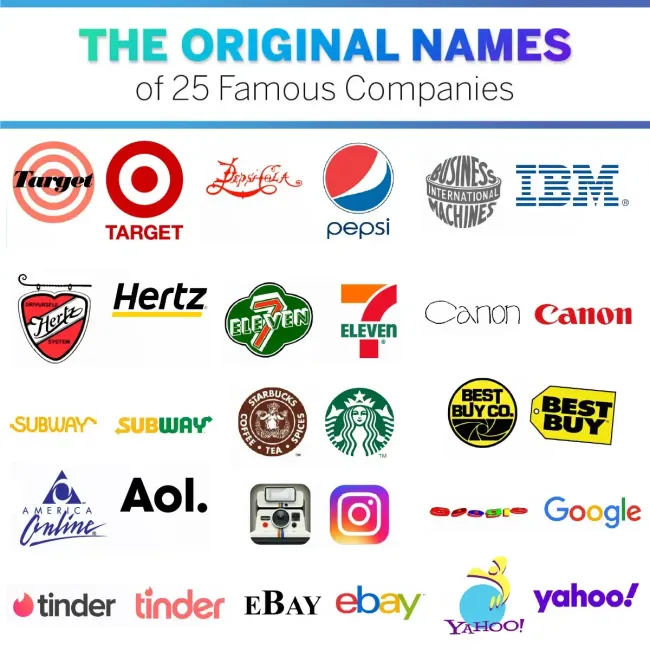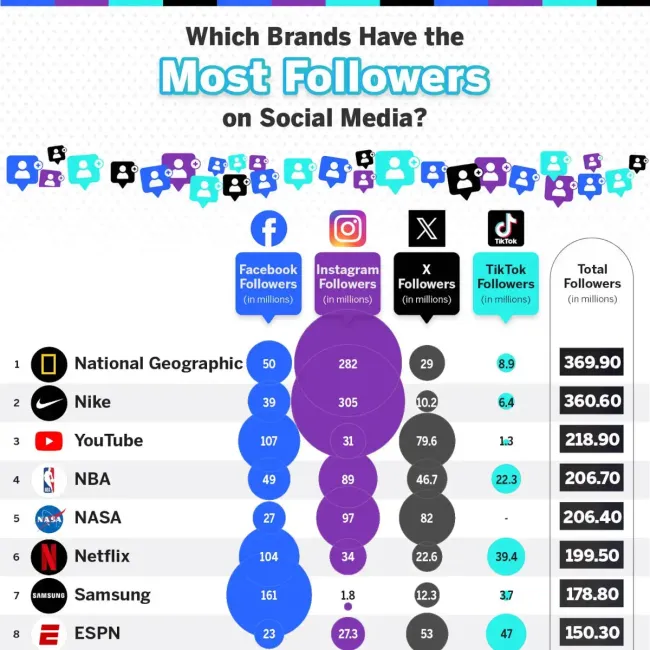Do you ever wonder how different life would be if you had been named something different? When it comes to branding, the right name can make or break the outcome of a company’s trajectory. Would we even know what Google is if it had remained as “BackRub?” Would we be enjoying two-day shipping on Amazon if it kept Bezos’ original name of “Cadabra?” Cadabra Prime does not quite have the same ring to it. While many major company name changes make sense, there are some that have ignited intense controversy and confusion. For example, why did Elon Musk change Twitter to X?
There are many famous companies that changed their names essentially from the get-go, while others operated under different names for decades until something (or someone) compelled a name change. The team at Qualtrics® created this visual guide exploring the original names of famous companies and the when and why behind the changes:

What was Google originally called?
Can you imagine a world where we say “Backrub it” instead of “Google it” when we want to look something up? If you know a bit about the history of Google, you may already know what Google’s first name was in 1996. Before it became Google, the initial search engine was called “BackRub.” This moniker was meant to represent how it analyzed the “back links” connecting the web. So how did the name Google come to be? David Koller of Stanford University recounts the origins of Google here.
One of Google’s founders, Larry Page, shared an office with several other graduate students, including Sean Anderson, Lucas Pereira, and Tamara Munzner. Page and his office mates discussed potential names for the rapidly evolving search technology. BackRub’s mission was “to organize the world’s information and make it universally accessible and useful”, so the name had to represent the act of indexing a vast amount of data. During a final brainstorming session in September 1997, the name Google was masterminded (with a little help from a typo). Sean verbally suggested the word “googolplex”, which is 10^(10^100), or 10 followed by 100 zeroes. Larry responded with the shortened form “googol”. Sean searched the term in the internet domain name registry database, but misspelled it as “Google.com”, which happened to be available. Larry liked the name and registered it for himself and co-founder Sergey Brin within hours. The official domain registration date of Google.com was on September 15th, 1997. The moral of the story? Don’t be afraid to make mistakes!
What was Amazon originally called?
What was Amazon’s original name? On July 5th, 1994, Amazon was officially founded under the moniker “Cadabra” (short for abracadabra) by Jeff Bezos from his garage in Bellevue, Washington. The name was meant to encompass how magical and innovative online shopping was at the time. However, Bezos was compelled to rebrand when a lawyer misheard the name as “cadaver.” He then considered other names such as Awake.com, Browse.com, Bookmall.com, and Aard.com. The latter was Bezos’ attempt to rank high in search engines that arranged websites in alphabetical order (back before search engine algorithms grew more sophisticated). Bezos ultimately chose the name “Amazon.” As the largest river in the world and an “exotic and different” place, Bezos felt it encompassed his ambitions of creating a massive online marketplace.
What was Pepsi called originally?
What was Pepsi originally called? Before the bubbly, syrupy sensation was known as Pepsi, it was called “Brad’s Drink.” Beginning in 1983, New Bern pharmacist Caleb Bradham created a carbonated beverage he called “Brad’s Drink.” He served the concoction from the soda fountain in his pharmacy on the corner of Pollock and Middle Streets. Equipped with some medical training, Bradham formulated his sweet and bubbly brew with the enzyme pepsin and cola nuts. He believed these imbued it with health, energy, and digestive benefits. It is likely that these ingredients inspired him to rename the beverage “Pepsi-Cola.” He officially incorporated the Pepsi-Cola Company in 1902 and patented his formula shortly thereafter. Pepsi’s success burst forth from there; by 2010, the beverage was being bottled by over 300 companies across 24 states and was enjoyed worldwide.
What was Target called originally?
Before Target became a household name along with its signature bullseye theme, it began as Goodfellow Dry Goods. Target’s legacy began when the Westminster Presbyterian Church in downtown Minneapolis burned down amid the Panic of 1893. In an effort to secure the revenue needed to rebuild, the congregation urged parishioner George Dayton to purchase the empty corner lot near the original church’s location. He constructed a six-story building on the newly purchased property and convinced the Reuben Simon Goodfellow Company to move a Goodfellows department store unit into it. By 1902, its owner retired and sold his portion to Dayton. In 1903, it became the Dayton Dry Goods Company, and then in 1910, it was shortened to the Dayton Company. From there, the Dayton Company evolved into a thriving retail chain business. While working for the Dayton Company, businessman John. F Geisse (who also founded the Wholesale Club, Walmart’s inspiration) developed the concept of upscale discount retailing. This lead to the founding of the first Target in 1962. After a few floundering years of lost profits, this store reported its first gain by 1965, sparking the establishment of more units. The retail chain radiated like a bullseye across America and finally, in 2000, the Dayton-Hudston Corporation changed its name to Target Corporation. Today, Target pays homage to its roots with the Goodfellow & Co. merchandise line.
What 25 famous companies were originally called


